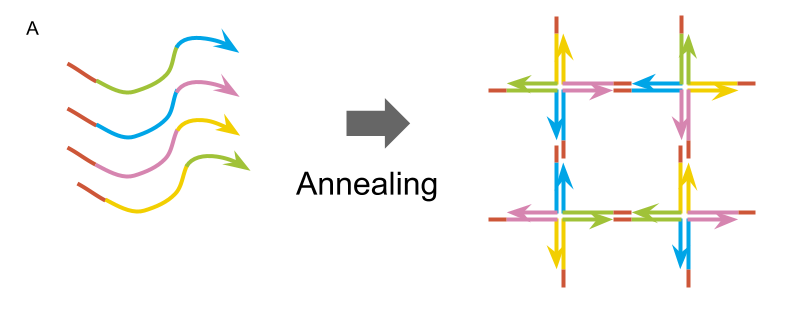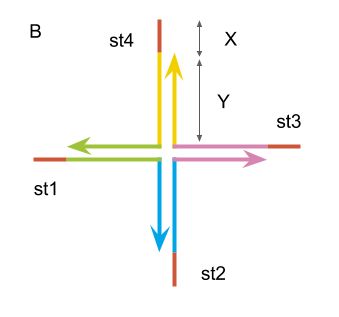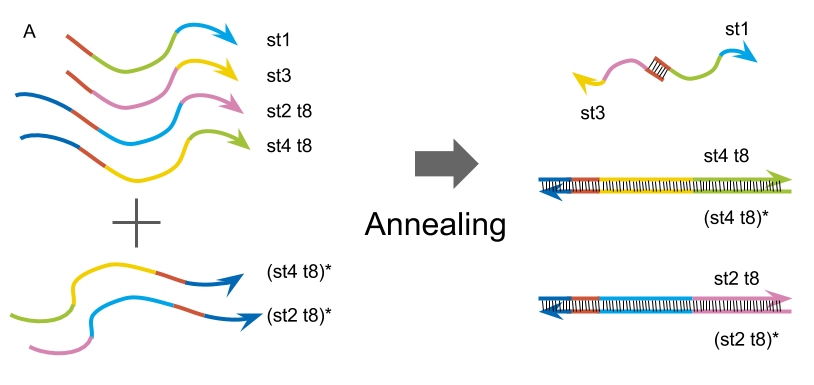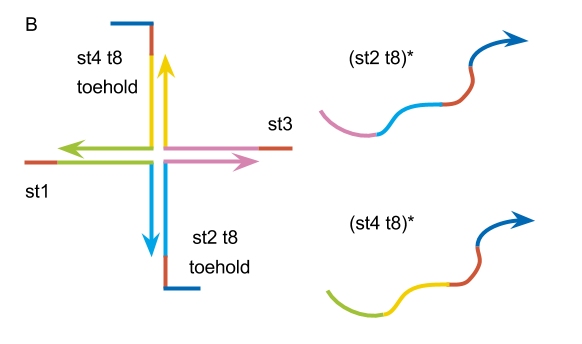Design
There are a lot of studies for controlling the gel-sol transition of DNA hydrogel formed a three-dimensional structure by combining partially complementary DNA sequences.


st1: 5’- TGGATCCAGTTTGTTATCGCAGGAGCGTCGGTATTCAAA -3’
st2: 5’- TGGATCCAGTTTGAATACCGACGCCACGACCTAATCTTA -3’
st3: 5’- TGGATCCAGTAAGATTAGGTCGTGATGGTGAAATGTAAA -3’
st4: 5’- TGGATCCAGTTTACATTTCACCATTCCTGCGATAACAAA -3’
Fig.1: Basic DNA hydrogel motif.
(A) Image of the when DNA sequences form structure after annealing. (B) Basic DNA hydrogel motif and detail of the DNA sequence.
We first prepare the basic DNA hydrogel, which is X-shaped motif, from the reference[1] and then control the state of the gel and the state of the liquid by adding the sequences.
A DNA hydrogel was designed that the X motifs are bonded to each other by the 9 base sticky ends and the number of Y bases to be linked with the adjacent sequences is 15 bases, shown in Fig. 1. In our design, all bases of sequences are complementarily bind.
In order to manipulate the state of the gel, st2 and st4 was extended from the basic DNA hydrogel sequence by 8 bases on the 5'end, and a sequence complementarily binding to the extended sequence was designed.


st2 t8 : 5’- CACTCTTCTGGATCCAGTTTGAATACCGACGCCACGACCTAATCTTA -3’
(st2 t8)*: 5’- TAAGATTAGGTCGTGGCGTCGGTATTCAAACTGGATCCAGAAGAGTG -3’
st4 t8 : 5’- CACTCTTCTGAATCCAGTTTACATTTCACCATTCCTGCGATAACAAA -3’
(st4 t8)*: 5’- TTTGTTATCGCAGGAATGGTGAAATGTAAACTGGATCCAGAAGAGTG -3’
Fig.2: DNA hydrogel with sequence extension of 8 bases.
(A) Image of the appearance of DNA sequence when the gel is liquefied. (B) Image of the motif formed by the sequence which extended 8 bases.
(st2 t8)* is complimentary bind to st2 t8, which is 8 bases extended sequence, after annealing together with DNA hydrogel forming sequences from the high-temperature state. st2 t8 is consumed by (st2 t8)* during the annealing, it is expected that the motif, lack of st2 t8, will be formed. At the same time, also for st4 t8, after annealing sequences, the motif without st4 t8 is formed in the same way with st2 t8 and gel is not built. We believe that this design can realize new control method for gel-sol transition of DNA hydrogels.
Reference
[1] Kandatsu, D. et al. “Reversible Gel-Sol Transition of a Photo-Responsive DNA Gel.” Chem Bio Chem 17, 2016, 1118-1121